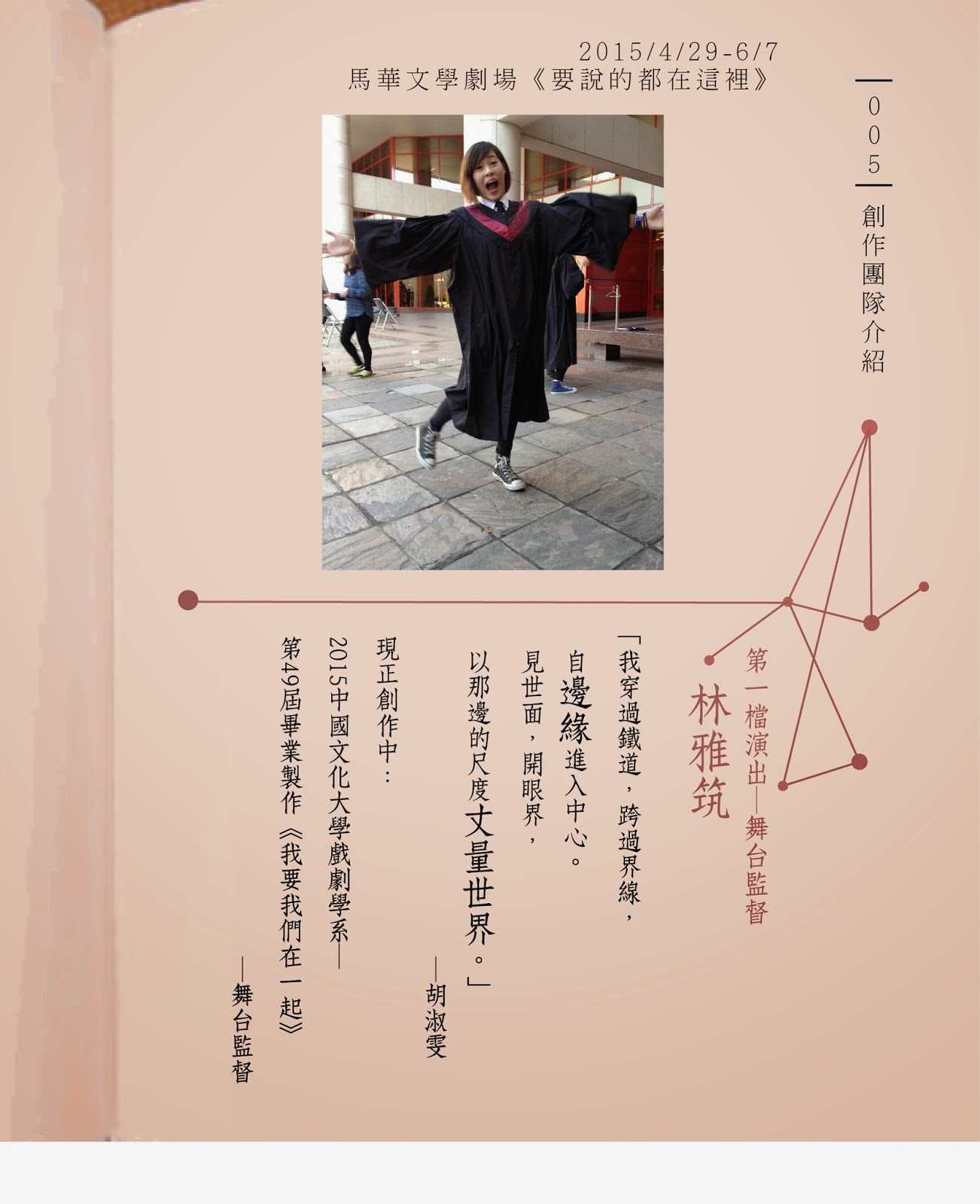黃思農《山瘟》
Q1:這次創作的理念是?
A1:
這個演出處理的不是歷史,而是記憶,死者的記憶以一種碎裂的形式存於我們語言之中並不斷的自我變造。所以,這個創作對於實存或者虛構的馬共與台共,從來就不可能以紀念碑式的悼亡作為路徑,而是不斷對同一個事件現場的解碼、轉譯和再挖掘,唯有在這個過程裡,我們對歷史的叩問以「當下」(the presence of the Jetztzeit)為基點。
Q2:在創作過程中,最想分享的一件事情?
A2:
馬共與台共是由小說的閱讀延伸出的關注,在我焦慮於作品涉及的議題如此巨大及牽涉大量的資料搜集時,友人杰廷剛好從德國回台,聽我談了一下午自己的焦慮,他跟我講了一段卡夫卡的短篇,故事關於臨終前的國王與傳令大臣,多少讓我確立了這個作品的方向,以及斷簡殘篇式的組合及思想斷片的引用,作為路徑的可行性。就像這則故事所體現的,「訊息永遠處在傳遞(in sent)的過程之中。」
我想與你們分享:
“The Emperor—so they say—has sent a
message, directly from his death bed, to you alone, his pathetic subject, a
tiny shadow which has taken refuge at the furthest distance from the imperial
sun. He ordered the herald to kneel down beside his bed and whispered the
message in his ear. He thought it was so important that he had the herald speak
it back to him. He confirmed the accuracy of verbal message by nodding his
head. And in front of the entire crowd of those witnessing his death—all the
obstructing walls have been broken down, and all the great ones of his empire
are standing in a circle on the broad and high soaring flights of stairs—in
front of all of them he dispatched his herald. The messenger started off at
once, a powerful, tireless man. Sticking one arm out and then another, he makes
his way through the crowd. If he runs into resistance, he points to his breast
where there is a sign of the sun. So he moves forwards easily, unlike anyone
else. But the crowd is so huge; its dwelling places are infinite. If there were
an open field, how he would fly along, and soon you would hear the marvellous
pounding of his fist on your door. But instead of that, how futile are all his
efforts. He is still forcing his way through the private rooms of the innermost
palace. Never will he win his way through. And if he did manage that, nothing
would have been achieved. He would have to fight his way down the steps, and,
if he managed to do that, nothing would have been achieved. He would have to
stride through the courtyards, and after the courtyards through the second
palace encircling the first, and, then again, through stairs and courtyards,
and then, once again, a palace, and so on for thousands of years. And if he
finally burst through the outermost door—but that can never, never happen—the
royal capital city, the centre of the world, is still there in front of him,
piled high and full of sediment. No one pushes his way through here, certainly
not someone with a message from a dead man. But you sit at your window and
dream of that message when evening comes.”
- translation by Ian Johnston,
An Imperial Message by Frank Kafka
Q3:從文本中,又有獲得什麼樣的感受呢?
A3:
如何閱讀?如何詮釋?我想到早期神秘主義者的符號指向:眼前的文本交織成網,真理永遠匿藏於其後。於是,對真實的欲求,與對言說和文字的不信任共生。
作為新生代的馬華文學作家,黎紫書許多短篇都涉及對同一虛構事件或歷史現場的回憶與挖掘,《山瘟》的馬共書寫,很自然而然讓我對應了近年剛出土的台共文獻,巧合的是,因為這段時間我的另外一個演出,再拒劇團的《燃燒的頭髮》,亦涉及1930-1950年代,跨越了日據時代到戰後的超現實美學及左翼思潮。
翻閱著第一代抗爭者的檔案與資料,一封封歷經了幾十年也無法傳遞至家人手中的獄中絕命書,我思索著生者與死者記憶連結的方式,偶然間,漢娜鄂蘭描繪班雅明的文字給了我一些線索,她談到卡夫卡這一代戰前猶太知識份子對於「繼承」猶太傳統的抵拒,因為傳統就是一種權威的歷史性呈現,在他們的時代,傳統的斷裂與權威的淪喪是無可補救的,而我們必須找到另一種面向歷史的態度,這個態度以對過去斷簡殘篇的「引用」為路徑,將原來的文字從既有的系統性的權威論述、連貫的語境中割裂和破壞出來,將它與現當代文本並置,彼此補充、辯證和對話。由此來看,黎紫書在《山瘟》裡對農民曆的引用,對我來說有同樣的意義。
不論我自己的創作脈絡,或者近年台灣的世代論述書寫所反映,我認為「拒絕繼承」,亦對應了現在我們這一代的處境。
Q4:以一句話總結此次創作吧:
A4:
「起源即目標」
-
Karl Kraus, Worte in Versen, Vol.1
Q5:想請問過去演出經歷有?
A5:
黃思農是劇場與音樂雙棲的創作者,歷年在各大小劇團、藝術節擔任過劇場編導、策展人、作曲、錄像、現場樂手和音效設計,亦曾任台北與澳門藝穗節的駐節藝評人,破報與每週看戲俱樂部的特約撰稿。20歲時與友人共同創立再拒劇團,,並擔任再拒劇團團長至今。07年黃思農發表“微型劇場”宣言,策劃第一屆再拒劇團公寓聯展,並編導搖滾音樂劇《沉默的左手》,以高捷泰勞、法國穆斯林移民的抗暴事件切入,反思東南亞新移民在台處境。其編導及音樂演出,以環境劇場、音樂劇場與詩劇為主,涵蓋非敘事與疏離手法的運用,及結合物件、聲音藝術和多媒體藝術之跨域創作。演出足跡遍及於台北、東京、澳門、柏林、埃爾福特、伊斯米爾……等多個城市。
09與10年黃思農分別在台北、澳門兩地演出《漢字寓言:忘》,結合現場音樂與錄像裝置的反烏托邦劇,獲該年度台新藝術獎台灣年度表演藝術十大。2010年於台北首演的《美國夢工廠》,探討全球文化均質化影響下當代的勞動青年處境,該戲於2012年在 180件亞洲作品中,入選東京藝術節(F/T)“新銳公募”。同年又以無演員的意識流劇場為命題,在再拒劇團策劃跨界劇展《接下來,是一些些消亡(包括我 自己的)》,此展演於2013年9月入選英國卡爾第夫(Cardiff)舉辦的世界劇場設計展(World Stage Design)全球藝術家計畫「FOUR at WSD」,為該計畫唯一的亞洲藝術團隊。2014年則參與再拒劇團《諸神黃昏》聲音劇場的集體創作。
黃思農合作過的樂人與劇團亦相當廣泛,從舞踏、帳篷劇、前衛小劇場、美術館、到偶劇,皆可看見他現場演出的身影。2008與2013年分別在台灣與澳門兩地發表劇場原聲創作專輯。他善於用音樂營造空間與畫面,現場常使用Loop堆疊不同的弦樂音層與節奏,製造龐大的音場與和聲,並將各種聲音如抗爭現場、田野錄音,編排入劇場及舞踏音樂中,在各種聲響與音樂即興的張力裏與現場表演者對話。

















